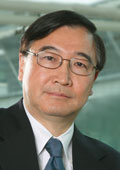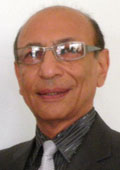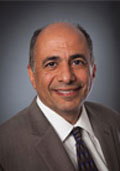Keynotes at ASQED 2012
July 10-11
Applied Research and Technology Transfer in Hong Kong
 Dr Nim-kwan Cheung
Dr Nim-kwan CheungChief Executive Officer
Applied Science and Technology Research Institute (ASTRI)
In his keynote speech Dr. Cheung will cover the history of the establishment of the Hong Kong Applied Science and Technology Research Institute (ASTRI), and its growth trajectory from 3 to 600 researchers. This is followed by a discussion of the business model and technology transfer and spin-off processes. Examples of research projects undertaken by the 5 big research domains (i.e. Communications Technologies, Enterprise and Consumer Electronics, Integrated Circuits Design, Material and Packaging Technologies, Bio-medical Electronics) and the Exploratory Research Laboratories will also be given.
About Nim-kwan Cheung
Dr Cheung Nim-kwan is Chief Executive Officer of Hong Kong Applied Science and Technology Research Institute (ASTRI), a 600-member ICT research center established by the Hong Kong Government. He received his B.Sc. degree from University of Hong Kong and Ph.D. degree from California Institute of Technology, and has held different research and management positions at AT&T Bell Labs and Bellcore. From 1999 to 2002, he was Vice President of Applied Research Government Program in Telcordia Technologies, managing a Government-funded research program that grew at double-digit rates annually. Dr Cheung was a pioneer in single-mode fiber optics communication systems during the early days of lightwave communication. As District Manager of Advanced Lightwave Technologies in Bellcore in the 1980s, he established three world class research teams in high-speed, coherent, and sub-carrier multiplexed lightwave communications systems. Dr Cheung was an early investigator of gigabit networks in the 1990s. He conceived and created many innovative gigabit and optical networking testbeds that have later become the blueprint of the optical Internet infrastructure of to date. In 2005, Dr Cheung was elected the 18th President of the IEEE Communications Society, an international professional organization with 45,000 members in 180 chapters around the world. He has published over 150 peer reviewed articles, and has served in different editorial positions, including Editor-in-Chief of the IEEE Communications Magazine. Dr Cheung was a consulting professor at Stanford University from 2004 to 2009. He is Fellow of IEEE and Telcordia Technologies, and a member of the Research Grants Council in Hong Kong. Dr Cheung has received numerous awards and honours, including Bellcore Award of Excellence and University of Hong Kong Faculty of Science Distinguished Alumni Award.
Emergence of New Markets: can business survive without a better technology roadmap?
 Professor Kamran Eshraghian
Professor Kamran Eshraghian President iDataMap Corporation, Australia, and Distinguished Professor, CBNU, Korea
The presentation by the way of examples will highlight the evolutionary nature of progress in technology and will highlight the changes that have taken place during the last decade in market place primarily driven by innovators. Some focus will be placed upon the panacea for a new model that would facilitate growth between research and educational sectors and business. What this new market could look like?
About Kamran Eshraghian
Kamran Eshraghian is best known in international arena as being one of the fathers of Very Large Scale Integration - having influenced two generation of researchers in both academia and industry in silicon chip design. He has held over 40 patents and co-authored six textbooks including the classic text "Principles of CMOS VLSI Design: a systems perspective" used by over 800 universities globally. He was the holder of Inaugural Ferrero Family Chair in Electrical Engineering at University of California, Merced, prior to his move to Chungbuk National University, Korea, as the Distinguished Professor, World Class University (WCU) program. He obtained his PhD., MEngSc., and BTech., degrees from the University of Adelaide, South Australia. In 2004 he was awarded a Dr.-Ing e.h., (Doctor of Engineering) from the University of Ulm, Germany, for his research into integration of nanoelectronics with that of light wave technology - thus creating a new design domain for future intelligent Systems on Chip (iSoC) technologies. In 1979, he joined the Department of Electrical and Electronic Engineering at the University of Adelaide, South Australia, after spending some ten years with Philips Research, both in Europe and Australia. In 1994, he was invited to take up the Foundation Chair of Computer, Electronics and Communications Engineering in Western Australia, and became the Head of School of Engineering and Mathematics and Distinguished University Professor and subsequently became the Director of Electron Science Research Institute. In 2004, he founded ELabs as part of his vision for horizontal integration of nanochemistry and nanoelectronics with those of bio- and photon-based technologies, thus creating a new design domain for future intelligent System on System (iSoS) research. He has lectured widely, been keynote speaker, and presented over 200 workshops in large scale integrated and multi-technology Systems on Chip systems. He has founded six High Technology companies, providing intimate link between University research and industry. Currently he is the President of iDataMap Corporation and serves as the Chairman of the Board of Directors, is a Distinguished Professor at CBNU and holds an Visiting Chair at UiTM. Professor Eshraghian also served as a Continental Counsellor on the Australasian Board from 1985 to 1995. He is a Fellow and life member of the Institution of Engineers, Australia.
Tech and Space: A Symbiotic Relationship
 Rich Goldman
Rich GoldmanVice President, Corporate Marketing & Strategic Alliances, Synopsys, Chief Executive Officer, Synopsys Armenia
Mr. Goldman's presentation, titled "Tech and Space: A Symbiotic Relationship", will examine the close linkage between the development of the semiconductor and space industries from the '50s to the present. He will explore how the past achievements of both industries have paved the way for astounding new technology and quality advances that will change the way we inhabit our own world and travel beyond it.
About Rich Goldman
Rich Goldman is the vice president of Corporate Marketing and Strategic Alliances for Synopsys and CEO of Synopsys Armenia, which the National Assembly of The Republic of Armenia proclaimed the best company in the country in 2005, and a finalist for the 2010 US Secretary of State ACE Award. His current responsibilities include Marketing Communications, Public Relations, Events, Creative Services, Web, Market Research, Executive Speaking placement and preparation, Community and Employee Communications, Strategic Alliances, University Programs, Standards, and Industry Relations. He is the Chairman of the Board of the Synopsys Outreach Foundation and of the Synopsys Charitable Foundation for Armenia. Rich is a guest Professor at the Chinese Academy of Science, and is a Commissioner of the Advanced SOC Design Joint Lab Academic Committee there. He is an honorary Professor at Moscow Institute of Electronic Technologies. He is a trustee of the State Engineering University of Armenia and the SEUA Foundation and was awarded the highest award from both Yerevan State University, and the State Engineering University of Armenia, the Gold Medal, for his contributions to technology education in Armenia. In 2009, Rich received the 'Andranik Ozanyan' Gold Medal of the Republic of Armenia Ministry of Defense. In 2010 he was awarded the Medal of Honor, the highest award of European Regional Educational Academy (ERIICTA). With the President of Armenia, Rich established and awards the annual Presidential IT Awards to honor that country's top engineering students. Rich conceived of and serves as cochairman of The President of Armenia's Award for Outstanding Contribution to Humanity Through IT. Rich is the cofounder and cochairman of ArmTech Congress, the official high tech business conference of the government of Armenia. Designated as the 'Man of the Year 2008 in Armenia', he recently received a citation from the National Academy of Sciences of the Republic of Armenia. Rich is President of the Organizing Committee of the Armenian Microelectronics Olympiad. In 2005-2009 he chaired the DAC pavilion panels committee. He is a member of the Syracuse University Society of Fellows, and an Honored Member of the Russian Armenian University Friendship Club. Rich currently serves on the Board of Directors of the Silicon Valley Technical Institute and the board of editors of 'Economics' Magazine. Prior to joining Synopsys eighteen years ago, Rich managed the ASIC library and design support software group while at Texas Instruments for 10 years. Rich started up TI ASIC's Bangalore, India operation. Prior to TI, Rich worked at IBM, developing the digital simulator, AUSSIM. Rich has been active in standards organizations such as Accellera, EDIF, IEEE, Si2 and OVI for more than 20 years. Rich chaired the EDIF Technical Committee, co-chaired the RAPID Board of Directors, and was a member of the EIA/EDIF Steering Committee and Si2 Board of Directors. Currently, Rich chairs the EDAC Interoperability Committee. Rich earned a BSCS from Syracuse University, an MBA and MS Engineering Management from The University of Dallas, and an honorary Doctorate from The State Engineering University of Armenia. In 2009 Rich was presented the Award of the President of Armenia for his significant contribution to the establishment of the Annual Educational Award of the President of Armenia for the best IT Students. In Sept 2010, Rich was selected to present at TED Talk.
Recent Development and Progress for Nonvolatile Memory for Embedded Market
 Dr. Saied Tehrani
Dr. Saied Tehrani Senior Vice President and Chief Technology Officer, Spansion
Nonvolatile memory market is expanding rapidly to over $25 billion focused on the development of higher density and low cost memory solutions for consumer and industrial applications. Many of the consumer applications require low-cost high density memory. On the other hand, embedded applications also demand support for extended temperatures and significant reliability. These stringent requirements, along with the perennial business requirement to manage costs, present both business and technology challenges for NAND and NOR vendors. These challenges are worth pursuing as the embedded market continues to expand into industrial, automotive, consumer appliance, medical and communications computing platforms. This presentation addresses how NAND and NOR suppliers can take on the challenge and meet their customers' technical and business needs. It will outline the products nonvolatile memory providers need to deliver into the market, as well as the architectural, validation and scalability challenges.
About Saied Tehrani
Dr. Saied Tehrani is senior vice president and chief technology officer at Spansion, responsible for technology development, strategy and new products. He has over 25 years of experience in the semiconductor industry in various leadership positions and has a strong track record of developing new and differentiating products based on innovative technologies. His work has been recognized with over 75 U.S. patents, over 70 co-authored articles in technical journals and many awards including the IEEE Daniel Noble award. Prior to joining Spansion, Tehrani was founder and chief operating officer of Everspin Technologies, Inc., where he was responsible for manufacturing, supply management, technology development, and new product introduction. He oversaw the development of over 50 new MRAM products in less than two years including the family of x8 and x16 I/O products ranging from 256kb to 16 Mb densities, low power serial interface family of products, and embedded MRAM with microcontrollers product. Prior to Everspin, he was director and fellow, Analog and Mixed Signal Technologies at Freescale Semiconductor and held several leadership positions during his 20 years at Motorola. Tehrani holds a doctorate and master's degree in electrical engineering from the University of Florida and a bachelor's degree in electrical engineering from the University of North Carolina.

